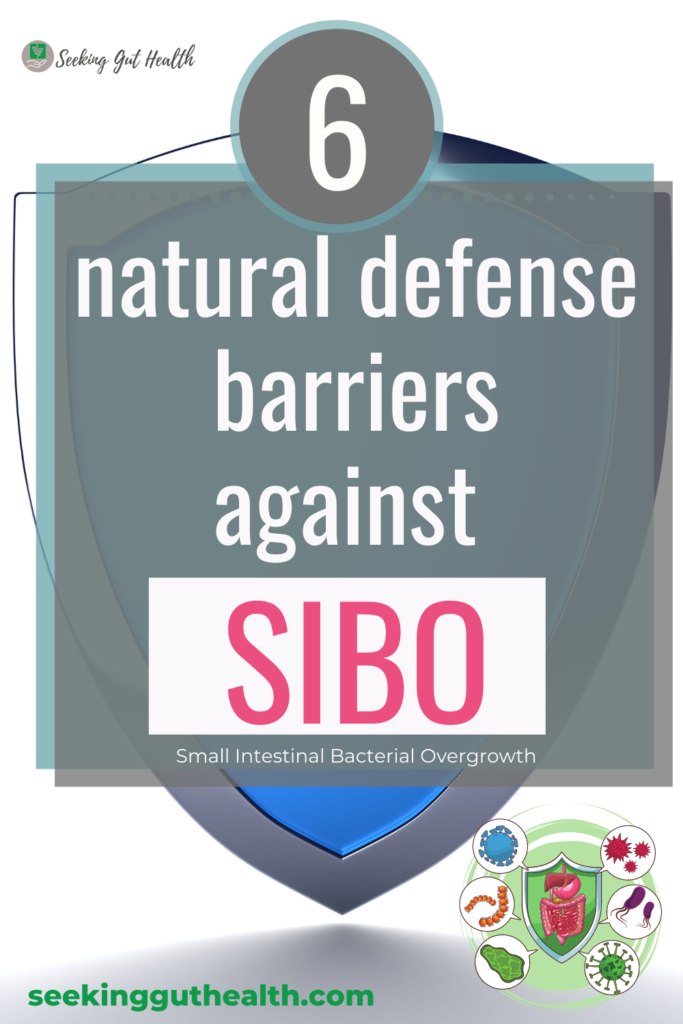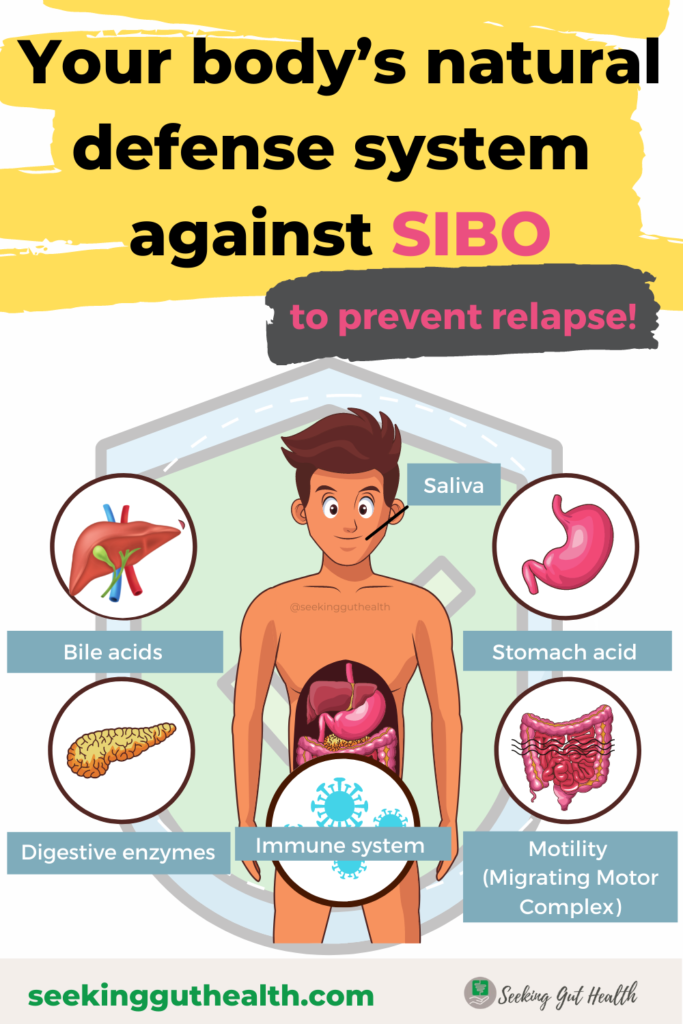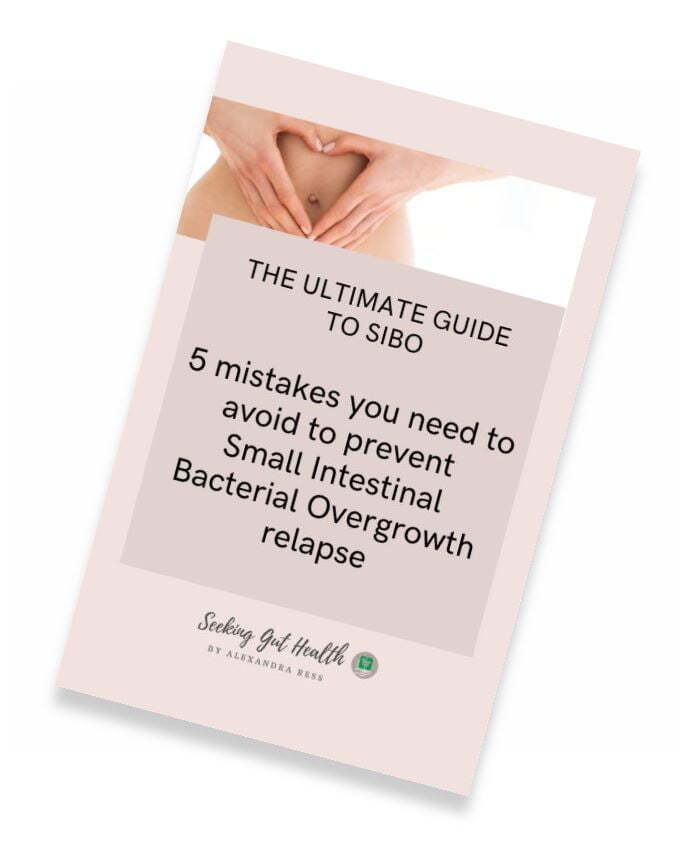Discover your body's 6 natural defense barriers against SIBO
Your body has many different defense mechanisms to deal with any possible infection or microorganism attack, or potential overgrowth (bacterial, fungal). Any dysfunction in the defense system may contribute to the development of (re-occurring) SIBO (Small Intestinal Bacterial Overgrowth).

What is SIBO?
SIBO is defined as the presence of excessive bacteria in the small intestine. Say the problem is that there are too much bacteria and/or the wrong type of bacteria present in the wrong place. If you have SIBO, then you may experience excess/trapped gas, (extreme) bloating, diarrhea and/or constipation, abdominal pain, cramping, food sensitivities, chronic fatigue, brain fog, skin issues, and the list goes on. (1)(2)
Be sure to test for SIBO before you jump on any elimination protocol. It is also essential to check what type(s) of overgrowth you have as treatment protocols may be different.
Now, many people solely focus on just eliminating the overgrowth by using herbals or even antibiotics or being on strict diets, which can be a crucial part of the process. Still, more important is finding and resolving the root causes of SIBO, whenever possible, to prevent relapse.
Some of the contributing factors could be some dysfunctions in the body's natural defense system, such as low stomach acid, poor bile flow, disordered or even absent motility, etc.
Let's look at some of them one by one:
How your body protects you from infections or overgrowth (SIBO)?
1. Saliva
Saliva, produced by the salivary glands, belongs to our body's first line of defense against infections. Saliva consists of around 90% water, but it contains several chemical compounds with antibacterial properties against pathogens. One of them is the mucus in the mouth, which stimulates white blood cells to form a 'net' that traps bacteria. (3) Moreover, saliva contains lysozyme (an enzyme), and lactoferrin that can break down the cell walls of many bacteria.
Saliva also helps maintain our digestive system functioning effectively by adding beneficial components to the food, such as enzymes that help pre-digest starches and fats. (4) That is why proper chewing is so important.
Interestingly, according to studies, oral bacteria can travel down to the gut and affect the microbiome and the immune system of the gut. It is logical since we usually swallow a massive amount of saliva daily that contains a large number of oral bacteria. Generally, only a tiny portion of the ingested oral bacteria may colonize a healthy intestine. However, in case of any illness (IBD, GERD, etc.), many bacteria were found in the intestine, and a dysbiotic gut may potentially lead to problems in other parts of the body. Good oral hygiene, adequate stomach acid level, pre-and probiotics may help improve oral & gut health. (5)
2. Stomach acid
Contrary to the commonly accepted belief that we have issues due to too much stomach acid, many SIBO patients actually have low stomach acid. A proper gastric acid or hydrochloric acid (HCl) secretion is needed not just for digesting food but also for eliminating bacteria, yeast, and parasites present in the food. It stimulates the digestive tract further along to promote the production of digestive juices to break down our foods into smaller particles properly. Unfortunately, stomach acid starts to decrease as you age, significantly above the age of 65. (6)
If you cannot digest the food you eat due to insufficient gastric acid, you may be malnourished, and bacteria will feed on these undigested food particles. Low stomach acid level is also a risk factor for SIBO because it will not be able to eliminate bacteria and keep in check in the small intestine. (7)
There are several reasons why someone has insufficient stomach acid production:
- Helicobacter pylori infection,(8)
- Medications (such as proton pump inhibitors (PPIs), antacids), (9)
- Chronic stress (10)
- Autoimmune gastritis (11)
- Hypothyroidism (12)
- Certain foods, mainly processed foods or food sensitivities
- Zinc deficiency (13)
- Eating too quickly
- Low protein intake
The most reliable way to check if you have either hypochlorhydria (insufficient stomach acid), hyperchlorhydria (excess stomach acid), or achlorhydria (no stomach acid) is the Heidelberg test or Gastric Function Tests. Doctors may also do a blood test to check for any nutrient deficiencies and other parameters. (14) (T. Ghosh, 2011)
Another easy and cheap way to check your stomach acid levels is a home-based baking soda test. All you need is baking soda. While this works well most of the time, there are a number of factors that may produce false positive or negative results, so the best is to repeat it several times at different times to get the most accurate results.
If you wish to perform the test:
Mix ¼ teaspoon of baking soda in 5 ounces or 1,5 dl glass of cold water and drink it on an empty stomach in the morning before you eat or drink anything else. Now check the time how long it takes for you to start burping. If it takes more than five minutes, or if you don't burp at all, it's an indication that your stomach acid might be low. Generally, if you have a proper stomach acid level, you should start burping within 2-3 minutes. If you burp too frequently or start right away, you may have too much acid.
So how can you support your stomach acid production?
- Be mindful about your eating habits – chew your food!
- Limit the intake of processed and high sugar-containing foods
- Drink apple cider vinegar diluted in a small glass of water before meals (might be not tolerated if you have histamine intolerance)
- Use bitter herbs or start your meal with bitter leaves such as rocket/arugula, dandelion leaves
- Eat your protein at the beginning of your meal
- Supplement with betaine HCl and pepsin – starting slowly and increasing your dosage as required. If you feel a burning sensation, it is already a sign that it is too much! Avoid if you have gastritis or ulcers. Check with your healthcare provider before you start taking HCl if it is safe for you!
Imagine taking back control of your body and living bloat-free. Download your free guide and learn the 5 MISTAKES you need to AVOID TO PREVENT SMALL INTESTINAL BACTERIAL OVERGROWTH RELAPSE.
Grab your copy today!
3. Bile acids
Bile is a greenish-yellow fluid continuously produced by your liver, stored, and eventually concentrated in your gallbladder. The biliary system, which includes the liver, gallbladder, and bile ducts, plays a vital role in the production, storage, and secretion of bile. When we eat food, bile gets released from the gallbladder into the small intestine via the bile ducts. The primary role of bile is to emulsify the fats in your small intestine to help the digestion process and absorption of fat and fat-soluble vitamins (D, E, K, A). (15)
But bile has another role besides food digestion. Bile belongs to one of your body's defense mechanisms. It serves to maintain the intestinal environment clean with its antibacterial properties. Bile keeps the bacteria in check and prevents them from colonizing the small intestine. One reason why someone may get SIBO is because of their sluggish gallbladder function and poor bile flow. (16)
Bile may also have an essential role in regulating motility and keeping the bacteria in check. (17) More about motility below.
What are the signs that your gallbladder needs more attention?
- Nausea
- Headache
- Bloating after meals
- Pain or feeling of heaviness under your right rib cage
- Right shoulder pain
- Constipation or diarrhea (when eating too much fat)
- Light or gray-colored stools
- Greasy, floating stools
- Not tolerating fats: oils, nuts, seeds, dairy products, etc.
You can support your gallbladder function when you:
- Avoid processed foods and excess starchy carbohydrates (white flour, sugar, potatoes, pasta, etc.)
- Avoid trans fats, hydrogenated fats, and processed vegetable oils
- Add essential fatty acids
- Add more (low-FODMAP) fibers like carrots, flax seeds, chia seeds, quinoa, etc.
- Avoid triggering foods (gluten and dairy are the most common ones)
- Address low thyroid function or autoimmune Hashimoto's hypothyroidism
- Add herbs: dandelion root, milk thistle, ginger root, globe artichoke, turmeric

4. Digestive enzymes
Similarly to stomach acid and bile acid, digestive enzymes are also required for proper nutrient absorption and the prevention of bacterial overgrowth.
The three main digestive enzymes are:
- protease (breaks down protein)
- lipase (breaks down fat)
- amylase (breaks down starches)
that further break down food into smaller particles. Digestive enzymes can be secreted from different glands: salivary glands, gastric glands, pancreas, and small intestine.
Besides, there are also brush border enzymes in the lining of the small intestine, which are involved in the final step in the digestion of dietary carbohydrates and proteins.
Pancreatic secretion supports intestinal integrity and controls the microbiota by supporting the mucosal barrier. Bacterial outgrowth is controlled by pancreatic antibacterial secretion. (18)
When you don't produce enough enzymes, you might experience:
- Bloating, gas
- Fatigue & lack of energy
- Fatty stools (Steatorrhea)
- Food intolerances
- Undigested foods in stools
- Skin rashes, acne
- Diarrhea and/or constipation
- Uncomfortable feeling of fullness all of the time
There are several reasons why people don't produce enough enzymes, such as Exocrine pancreatic insufficiency (EPI), chronic stress, infections, medications, leaky gut, poor eating habits, etc.
If you or your practitioner suspect that you lack digestive enzymes, then supplemental digestive enzymes can help your body process foods & absorb nutrients better. It is especially beneficial when you have food intolerances or mainly eat cooked foods. (19) (Lipski, 2011)
5. Motility (the Migrating Motor Complex (MMC))
One of the most common underlying causes of SIBO is an absent or disordered migrating motor complex (MMC). (20)
MMC is the housekeeper of your GI tract that gets activated during fasting periods (between meals and at night) and sweeps the remaining gut bacteria and food particles towards the colon, preventing the overgrowth of bacteria.
Nerve damage or structural problems such as adhesions, blind loops, and diverticulosis may block the bacterial clearance or facilitate backflow from the large intestine (in case of a dysfunctional or absent ileocecal valve, for example). (21)
So what does it mean when your MMC is out of order? It simply means that remaining food particles and bacteria stay in your small intestine for a longer time than usual, and bacteria can start feeding on that food waste and producing gas (contributing to bloating and other digestive symptoms). This would be a normal process if it would happen in the colon, where most of your bacteria reside.
This is one of the most important things to address when you have SIBO or slow motility.
There are several ways how you can improve your motility:
- Manage your stress (When we under stress, our digestive systems stops working correctly as it is not a priority at that moment, so as your MMC shuts down) - That is why it is crucial to stop and eat in a calm environment and not on the run (22)(R.M. Valori, 1986)
- Stop snacking and give your digestive system 4-5 hours of break between meals and possibly overnight fasting, so your MMC has a chance to work (23)
- Eat slow and chew your food properly
- Consider intestinal massage
- Apply vagus nerve stimulation techniques (23)
- Use motility agents (ask your doctor about them) to stimulate your MMC: some natural-based ones contain: ginger, artichoke extracts (24), 5-HTP (25), vitamin B6 (26)
6. Ileocecal valve
The ileocecal valve is a sphincter located in the last section of the small intestine (ileum), where it connects to the first portion of the large intestine (cecum). It opens to allow the digested food to pass downwards and closes to prevent the backflow of the colonic content or waste to the small intestines (ileum). (27)
The problem occurs when the valve is impaired. It means the valve opens too long and allows waste flow back up to the small intestines resulting in ileocecal valve syndrome (ICVS), which may predispose an individual to SIBO. (28) What causes the ICVS to happen is when the valve gets stuck in an open or closed position. An open ileocecal valve might result in SIBO or diarrhea, while a closed valve in constipation. Besides, gas production by the bacteria may also put further pressure on the valve. (29)
What causes the Ileocecal Valve Syndrome? (30)
- Dehydration
- Irritant foods: popcorn, chips, pretzels, nuts, seeds, whole grains
- Stimulants: caffeine products (coffee, black tea), cocoa, chocolate
- Alcohol
- Strong spices: chili, black and cayenne pepper, hot peppers
- Infections (parasitic, fungal, bacterial, viral)
- Stress and emotional trauma
- Unhealthy eating habits (under-chewing of food, eating too fast, too frequently)
- Adrenal imbalances
A study has suggested that dysfunction of this valve can contribute to symptoms such as bloating, gas, abdominal pain, constipation/diarrhea, heart symptoms, insomnia, nerve pain, muscle pain, stiffness, etc. (28)
How to have a properly functioning ileocecal valve? (30)
- Ileocecal valve massage
- Eliminate irritating foods from your diet
- Have mindful eating habits
- Chiropractic treatment
Other factors
The immune system and a healthy microbiome may also protect you against potential overgrowth.
Conclusion
When dealing with SIBO, it is important to focus on restoring the body's natural defense barriers against bacterial overgrowth and not simply getting stuck in the clearing phase.
When we talk about proper digestion and prevention of bacterial overgrowth, it is hydrochloric acid in the stomach and bile salts and a healthy digestive tract that work together to facilitate nutritional absorption. It is crucial to find and address the root causes and fix the contributing factors, so SIBO is not coming back once we eliminate it.
This post is only for informational purposes and is not meant to diagnose or treat any disease. I advise consulting with your healthcare practitioner regarding any treatment options or dietary changes.
- Dukowicz, A. C., Lacy, B. E., & Levine, G. M. (2007). Small intestinal bacterial overgrowth: a comprehensive review. Gastroenterology & hepatology, 3(2), 112–122.
- Bures, J., Cyrany, J., Kohoutova, D., Förstl, M., Rejchrt, S., Kvetina, J., Vorisek, V., & Kopacova, M. (2010). Small intestinal bacterial overgrowth syndrome. World journal of gastroenterology, 16(24), 2978–2990. doi.org/10.3748/wjg.v16.i24.2978
- Lund University. (2015, November 6). Mucus: The first line of defense. ScienceDaily. Retrieved June 23, 2021 from www.sciencedaily.com/releases/2015/11/151106062716.htm
- Fábián, T. K., Hermann, P., Beck, A., Fejérdy, P., & Fábián, G. (2012). Salivary defense proteins: their network and role in innate and acquired oral immunity. International journal of molecular sciences, 13(4), 4295–4320. https://doi.org/10.3390/ijms13044295
- Olsen, I., & Yamazaki, K. (2019). Can oral bacteria affect the microbiome of the gut?. Journal of oral microbiology, 11(1), 1586422. https://doi.org/10.1080/20002297.2019.1586422
- InformedHealth.org [Internet]. Cologne, Germany: Institute for Quality and Efficiency in Health Care (IQWiG); 2006-. How does the stomach work? 2009 Dec 31 [Updated 2016 Aug 21]. Available from: https://www.ncbi.nlm.nih.gov/books/NBK279304/
- Naylor, G., & Axon, A. (2003). role of bacterial overgrowth in the stomach as an additional risk factor for gastritis. Canadian journal of gastroenterology = Journal canadien de gastroenterologie, 17 Suppl B, 13B–17B. https://doi.org/10.1155/2003/350347
- Ansari, S., & Yamaoka, Y. (2017). Survival of Helicobacter pylori in gastric acidic territory. Helicobacter, 22(4), 10.1111/hel.12386. https://doi.org/10.1111/hel.12386
- Sieczkowska, A., Landowski, P., Gibas, A., Kamińska, B., & Lifschitz, C. (2018). Long-term proton pump inhibitor therapy leads to small bowel bacterial overgrowth as determined by breath hydrogen and methane excretion. Journal of breath research, 12(3), 036006. https://doi.org/10.1088/1752-7163/aa9dcf
- Hayase, M., & Takeuchi, K. (1986). Gastric acid secretion and lesion formation in rats under water-immersion stress. Digestive diseases and sciences, 31(2), 166–171. https://doi.org/10.1007/BF01300703
- Lenti, M. V., Rugge, M., Lahner, E., Miceli, E., Toh, B. H., Genta, R. M., De Block, C., Hershko, C., & Di Sabatino, A. (2020). Autoimmune gastritis. Nature reviews. Disease primers, 6(1), 56. https://doi.org/10.1038/s41572-020-0187-8
- Ebert E. C. (2010). The thyroid and the gut. Journal of clinical gastroenterology, 44(6), 402–406. https://doi.org/10.1097/MCG.0b013e3181d6bc3e
- Cho, C. H., Fong, L. Y., Ma, P. C., & Ogle, C. W. (1987). Zinc deficiency: its role in gastric secretion and stress-induced gastric ulceration in rats. Pharmacology, biochemistry, and behavior, 26(2), 293–297. https://doi.org/10.1016/0091-3057(87)90121-3
- T. Ghosh, D. I. (2011, April). Review article: methods of measuring gastric acid secretion. Alimentary Pharmacology & Therapeutics, 33(7), Pages 768-781. doi:https://doi.org/10.1111/j.1365-2036.2010.04573.x
- 15. Di Ciaula, A., Garruti, G., Lunardi Baccetto, R., Molina-Molina, E., Bonfrate, L., Wang, D. Q., & Portincasa, P. (2017). Bile Acid Physiology. Annals of hepatology, 16(Suppl. 1: s3-105.), s4–s14. https://doi.org/10.5604/01.3001.0010.5493
- Hofmann, A. F., & Eckmann, L. (2006). How bile acids confer gut mucosal protection against bacteria. Proceedings of the National Academy of Sciences of the United States of America, 103(12), 4333–4334. https://doi.org/10.1073/pnas.0600780103
- Hellström, P. M., Nilsson, I., & Svenberg, T. (1995). Role of bile in regulation of gut motility. Journal of internal medicine, 237(4), 395–402. https://doi.org/10.1111/j.1365-2796.1995.tb01193.x
- Ahuja, M., Schwartz, D. M., Tandon, M., Son, A., Zeng, M., Swaim, W., Eckhaus, M., Hoffman, V., Cui, Y., Xiao, B., Worley, P. F., & Muallem, S. (2017). Orai1-Mediated Antimicrobial Secretion from Pancreatic Acini Shapes the Gut Microbiome and Regulates Gut Innate Immunity. Cell metabolism, 25(3), 635–646. https://doi.org/10.1016/j.cmet.2017.02.007
- Lipski, E. (2011). Digestive Wellness: Strengthen the Immune System and Prevent Disease Through Healthy Digestion Fourth Edition.
- Vantrappen, G., Janssens, J., Hellemans, J., & Ghoos, Y. (1977). The interdigestive motor complex of normal subjects and patients with bacterial overgrowth of the small intestine. The Journal of clinical investigation, 59(6), 1158–1166. https://doi.org/10.1172/JCI108740
- Dukowicz, A. C., Lacy, B. E., & Levine, G. M. (2007). Small intestinal bacterial overgrowth: a comprehensive review. Gastroenterology & hepatology, 3(2), 112–122.
- 22. R.M. Valori, D. K. (1986). Effects of different types of stress and of "prokinetic" drugs on the control of the fasting motor complex in humans. Gastroenterology, 90(6), 1890-1900. doi:https://doi.org/10.1016/0016-5085(86)90258-1.
- Miyano, Y., Sakata, I., Kuroda, K., Aizawa, S., Tanaka, T., Jogahara, T., Kurotani, R., & Sakai, T. (2013). The role of the vagus nerve in the migrating motor complex and ghrelin- and motilin-induced gastric contraction in suncus. PloS one, 8(5), e64777. https://doi.org/10.1371/journal.pone.0064777
- Lazzini, S., Polinelli, W., Riva, A., Morazzoni, P., & Bombardelli, E. (2016). The effect of ginger (Zingiber officinalis) and artichoke (Cynara cardunculus) extract supplementation on gastric motility: a pilot randomized study in healthy volunteers. European review for medical and pharmacological sciences, 20(1), 146–149.
- Siegle, M. L., Bühner, S., & Ehrlein, H. J. (1990). 5-Hydroxytryptophan modulates postprandial motor patterns of canine proximal small intestine. Canadian journal of physiology and pharmacology, 68(12), 1495–1502. https://doi.org/10.1139/y90-227
- Martinoli, L., Fioravanti, A., De Luca d'Alessandro, E., Dante, D., Giraldi, G., & Palmery, M. (2012). Pilot study of the effect of vitamin B6 on the motility of guinea pigs ileum: possible implications for human intestinal motility. La Clinica terapeutica, 163(4), 275–279.
- https://en.wikipedia.org/wiki/Ileocecal_valve
- Roland, B. C., Ciarleglio, M. M., Clarke, J. O., Semler, J. R., Tomakin, E., Mullin, G. E., & Pasricha, P. J. (2014). Low ileocecal valve pressure is significantly associated with small intestinal bacterial overgrowth (SIBO). Digestive diseases and sciences, 59(6), 1269–1277. https://doi.org/10.1007/s10620-014-3166-7
- Miller, L. S., Vegesna, A. K., Sampath, A. M., Prabhu, S., Kotapati, S. K., & Makipour, K. (2012). Ileocecal valve dysfunction in small intestinal bacterial overgrowth: a pilot study. World journal of gastroenterology, 18(46), 6801–6808. https://doi.org/10.3748/wjg.v18.i46.6801
- Tannenbaum, R. (2016). Ileocecal Valve Syndrome. Online Link

Alexandra is a Functional Medicine Certified Health Coach & Holistic Nutritionist specializing in IBS, SIBO, and Gut Health. She helps her clients identify the root causes of their chronic gut issues with functional testing, supporting their bodies holistically and implementing the necessary lifestyle changes long-term to regain control of their bodies and enjoy food freedom. Book your FREE SIBO Assessment call now >>>

